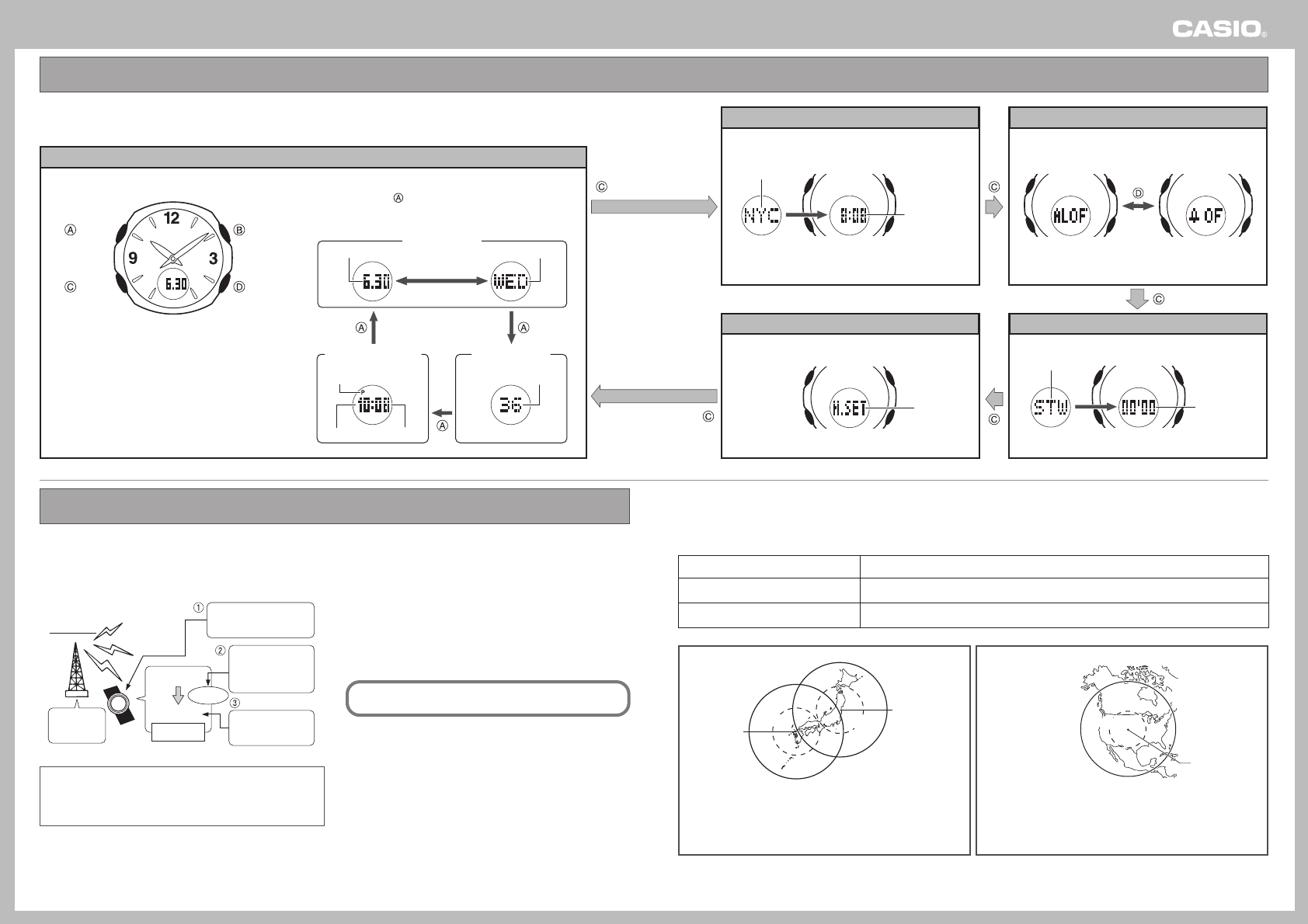
Operation Guide 3390
1
MA0406-EA
Each press of the
CC
CC
C button sounds a confirmation tone and cycles through available modes in the sequence shown below.
• The display will automatically revert to the Timekeeping screen if you leave the Alarm or Hand Setting screen displayed without performing
any operation for about two or three minutes.
World Time Mode Alarm Mode
Hand Setting Mode Stopwatch Mode
Current Time
in Selected City
City Code
Alarm
• Alarm off
Hourly Time Signal
• Hourly Time Signal off
Elapsed Time
Mode Indicator
Mode
Indicator
Timekeeping Mode
(Light)(Screen Switching)
(Mode switching)
Month.Day
Day of the Week
Seconds
Hour
PM indicator
(no indicator for AM)
Minutes
Seconds ScreenCurrent Time Screen
Calendar Screen
2-second interval
Days of the Week
SUN: Sunday MON: Monday TUE: Tuesday
WED: Wednesday THU: Thursday FRI: Friday
SAT: Saturday
Button Button
Button Button
Changing Display Screen Contents
Each press of the button cycles display contents in the
following sequence: Calendar Screen \ Seconds Screen \
Current Time Screen.
Modes and Display Screens
What is a radio-controlled watch?
Your radio-controlled watch is designed to receive a time
calibration signal that contains standard time data, and adjust its
current time setting accordingly.
Signal data
Cesium
atomic
clock
Transmitter
Internally
Decode
Watch
Time data
Signal is received
using built-in antenna.
Watch decodes
received data
and converts it
to time data.
Time is adjusted
according to time
data.
Long-
wave time
calibration
signal
After the watch receives the Standard Time signal, it performs
internal calculations to determine the current time. Because of
this, there may be an error of up to one second in the
displayed time.
Calibration Signal
• The Japanese calibration signal (Call Sign: JJY) is maintained by
the National Institute of Information and Communications
Technology (NICT). It is a long wave signal transmitted 24 hours a
day from the Mt. Otakadoya transmitter (40kHz) located in
Tamura-gun, Fukushima Prefecture, and from the Mt. Hagane
transmitter (60kHz) located on the border between Saga
Prefecture and Fukuoka Prefecture.
• The U.S. calibration signal (Call Sign: WWVB) is transmitted by
the National Institute of Standards and technology from Fort
Collins, Colorado.
Note that transmission of the standard wave may be
interrupted occasionally due to maintenance, lightening, etc.
How a Radio-controlled Watch Works
Reception Range
This watch is designed to receive the standard time calibration signal of Japan (JJY) or of the United States (WWVB). The signal that is
received depends on the current Home Time setting.
• For information about selecting a Home City, see “Configuring Home Time Settings”. For information about city codes, see the “World Time
City Code List”.
Home City
TYO
LAX, DEN, CHI, NYC
Transmitter
Either the Mt. Otakadoya signal (40kHz) or the Mt. Hagane signal (60kHz)
Fort Collins, Colorado signal
1000km
Mt. Hagane
(60kHz)
Mt. Otakadoya
(40kHz)
500km
1000km
500km
Japan Transmitter
Locations
• Under optimum conditions, the calibration signal should be
receivable up to 1,000 kilometers from the transmitter. Note
that the wave is relatively weak at distances greater than
500km, so reception may be poor at long distances.
U.S. Transmitter
Location
3000km
1000km
Fort Collins
• Under optimum conditions, the calibration signal should be
receivable up to 3,000 kilometers from the transmitter. Note
that the wave is relatively weak at distances greater than
1,000km, so reception may be poor at long distances.
• Geographic contours, nearby buildings, seasonal conditions, the time of day, can even make reception impossible even when you are within
range of the transmitter.
• Best reception is possible late at night.








